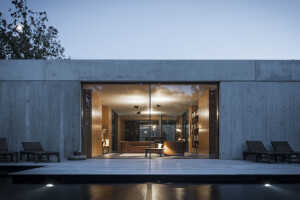Glenburn is approximately 1.5 hours drive north east of Melbourne in the rolling foothills of the Yarra Valley. The site is 20ha of re-invigorated farmland with a national forest abutting the north boundary. The house is located at the top of a hill and enjoys panoramic views of quintessentially Australian landscape. It is partially embedded into the hilltop as a means of protecting the occupants from the prevailing weather and buffering the west side of the building from extreme heat in summer. The plan extends my research into the notion of ‘abstract verandah’ to include a barcode motif in the plan. A series of discrete spaces, organised in a way to suit the client’s particular requirements, results in a coded arrangement that is unique to them – a tectonic thumbprint for living.
Our clients are committed to environmentally sustainable design (ESD) and the building skin (which is an identifiable part of my work and has the primary role of shading) includes solar collectors for power and hot water in this instance. The collectors are integrated into the skin which wraps over the roof to form a shading device for the two outdoor areas. The collectors are deliberately discrete – integral rather than attached to the architectonics of the building. This reinforces my position that environmental design should be seen as a normal, almost incidental part of the appearance of any building. The skin opens and closes allowing the occupants to further modify their internal environment. This philosophy underpins my approach to the RMIT Design Hub building, due to commence in 2009, where the same idea of integrated ESD results in a more technically sophisticated version of the same idea. In the RMIT building the skin can be upgraded over time to support the evolution of solar technology.
Other elements such as double glazing, rainwater harvesting and digital power management make this apparently simple house a sophisticated device for passive environmental management. Double glazing is still unusual in residential architecture in Australia. In this example argon filled low E coated glass is further enhanced by a split mullion detail that eliminates thermal bridging. The air gap between the structural floor slab and recycled timber floor slab is filled with a screed to enhance the performance of the in slab hydronic heating. In-slab sensors provide more accurate information to the house’s computer so that the efficiency of the heating is optimised and energy consumption minimised. Power to the house can be isolated and shut down through the building computer to minimise energy consumption and maintain battery life. Harvested rainwater is stored in a below ground 100,000 litre tank. This is the only source of water on the site and stored below ground to keep it cool. Drought tolerant indigenous vegetation used in the landscape design means that tank water isn’t required for maintaining the garden. The house can be opened to the prevailing summer winds and this combined with a high performance envelope and earth insulation keeps the house cool in the hot Australian summer without the need for air conditioning.













































